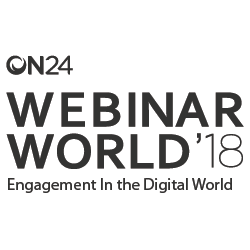 Last week I was fortunate enough to attend Webinar World 2018 Sydney. It was a great opportunity to discover what’s new in the webinar scene, the exciting enhancements coming within the ON24 platform and how marketers are using digital events to engage at scale. I also had the pleasure of being interviewed by CMO, Joe Hyland about how Simple is using webinars to attract, engage and retain. Here’s a snapshot of what was discussed:
Last week I was fortunate enough to attend Webinar World 2018 Sydney. It was a great opportunity to discover what’s new in the webinar scene, the exciting enhancements coming within the ON24 platform and how marketers are using digital events to engage at scale. I also had the pleasure of being interviewed by CMO, Joe Hyland about how Simple is using webinars to attract, engage and retain. Here’s a snapshot of what was discussed:
1. Develop a multi-layer webinar strategy
Before launching into webinars, think through your webinar strategy so you can get maximum benefit from the medium and maximum value for your time and energy, as well as budget.
Webinars are a great, cost-effective way to reach your audience at scale at a particular point in time, but they can be much more than that. Here are the 3 key ways we use webinars at Simple:
– For lead generation and thought leadership – think top of the funnel content that inspires!
– To work with our customers and help build their brand – so many of our customers are doing great things — if we can involve them in our webinars we can help them build their brand as well as create great content.
– For training and retention – live and on-demand webinars serve as the perfect tool for on-boarding and training.
2. Match your webinar topics to your content strategy
As it is for so many brands, content is hugely important for Simple. What’s become really important is figuring out how we can develop information and education pieces that span different formats because different people prefer different channels. Our webinars have really been a place for us to understand that.
So if we do a webinar on a topic, it’s likely we’ll complement it with an eBook, infographic or some templates or other content on the same topic. We then upload these resources to our online Resource Library to further engage live attendees.
3. Plan with the end in mind
When you’re planning your content for a webinar, start with the end in mind: what are your goals? For example, do you want people to be able to access it on-demand afterwards? What do you want your attendees to think, feel and do? What’s your call to action?
Also, how will your content work on-demand? Consider using evergreen content so it lives on and on…
4. Segment and re-use
While some of us enjoy watching a 45-minute webinar, others may only have an attention span for 15 minutes – always ensure you cater to as many as possible. Consider breaking your webinar up into sections so you can edit and re-use the video. For one of our recent webinars, we set it up in 3 parts so we could then cut it down into 3 smaller videos.
People digest content in a variety of different ways. You want to be able to stream it live, host it on demand and break it down into digestible content.
5. Pick presenters for their passion
I always pick presenters for their passion and enthusiasm. Who will talk about your topic in an engaging way and be able to break through the technology barrier?
A recent webinar of ours featured former McDonald’s global marketing and creative director Joe Talcott talking about how to write a brilliant creative brief. He loves creative advertising and the strategic thinking and insights that power them, and that passion really shines through when he talks about it.
When you get a great presenter, don’t hide them behind slides. Make sure you allow their natural enthusiasm to come through.
Remember, your presenter’s role is to present. Consider using a facilitator to manage any Q&A and ensure they have the opportunity to build rapport with your presenter. The more comfortable you can make the experience for all involved, the more natural it is going to be.
6. Don’t rehearse too much
You can always tell on the other side if someone is reading from a script. We encourage our presenters/panel to run through their content before the webinar, have a quick rehearsal and focus on getting to know each other.
We always film our webcasts live because it gives it a little bit more of an edge. People know things can’t necessarily be edited out. But have fun with it and show how human you are.
7. Use your audience interaction tools at the beginning
It’s important to remember that engagement doesn’t necessarily equal interactivity and that different topics/formats will require different tools.
When we begin a webinar we often start out by telling our audience we’re going to cover 3 key themes, and then we ask them to vote via a poll and let us know what they’d like us to focus on. This shows that it’s about them, and it also gets them familiar with the technology if you want to ask other questions later.
You can also introduce resources such as slides and other content along the way to keep people engaged — but only introduce one at a time. You don’t want distract or overwhelm your audience.
8. Measure, and survey the crowd
The days of judging your webinar success by attendance rates are long gone – for us, it’s about how engaged our audience is both in the live and on-demand environments. We always measure how many people attended live, who downloaded content, responded to polls and provided feedback in the exit survey.
The most crucial element of this? All data captured is seamlessly passed through to our CRM to ensure we can continue to build out profiles, nurture any leads and keep our sales teams across what is happening within their accounts. When it comes to feedback surveys, we also ask the same questions at the end of each event so we can benchmark our webinars throughout the year.
9. Integrate your webinar technology with your tech stack
As mentioned, the integration of our webinars with our marketing automation system is hugely important. If we couldn’t pass through the data, I don’t know if we’d even bother doing them.
This goes back to understanding your goals from the very beginning. If you’re running webinars for lead generation purposes, you don’t want to be exporting spreadsheets and playing with data following each event. Investing in integration will save you time and increase alignment between sales and marketing.
10. Promote, promote, promote!
While we host all our thought leadership webinars live, we invest heavily in getting people to watch them on-demand. Why? Because we know that our average live attendance rate is around 40%.
We always ask ourselves – how can we promote our on-demand webinars to the other 60% who didn’t attend or the rest of our community who didn’t even register?
We utilize our newsletters, blogs, related pieces of content and even our presenters. If we do choose to use social media, we make sure we provide video snippets that point back to our on-demand library.
So there you have it – the Simple approach to webinar marketing.
A huge thank you to the crew at ON24 for putting on an awesome event and for having me – #webinerd











